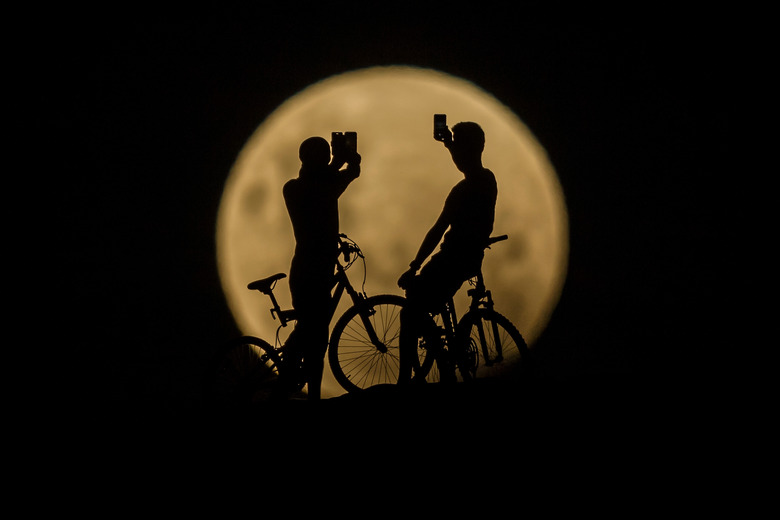3 Strange Things You Definitely Didn't Know About The Moon
Are you excited for this Sunday's total lunar eclipse and blood moon? We wrote all about it yesterday – so check out our story for all the details, including exactly why the eclipse is happening and what makes it a blood moon.
To catch you up: This Sunday, the Earth will start casting its shadow over the moon starting at about 9:30 p.m. EST. And you'll be able to observe a total eclipse for about an hour, starting at around 11:40 p.m. EST. Because of the way light reflects off the Earth, to the moon, then back, the moon will appear red (which is where the "blood moon" name comes from).
While you're moongazing, why not read up on other cool lunar phenomena? Check out these three weird facts about the moon – and how they might affect space exploration in the future.
Sometimes, the Moon Really Looks Bigger
Sometimes, the Moon Really Looks Bigger
Ever looked out on a clear night and sworn the moon seems brighter? Well, it's not your imagination. The moon follows an oval-shaped orbit around Earth, instead of a perfect circle. That means it's physically closer to Earth at some stages in its orbit than others.
The moon looks the biggest when it's in perigee – the point in its orbit when it's closest to Earth. And, at that point, a full moon is also called a supermoon. Each supermoon looks about 14 percent larger and 30 percent brighter than when the moon is in apogee – the point in its orbit where it's farthest from Earth.
Sometimes, It's an Optical Illusion
Sometimes, It's an Optical Illusion
A supermoon means the moon can appear a little bigger and brighter sometimes. But when you see the moon on the horizon and it seems massive, that's actually just your perception. The optical illusion where the moon appears much larger on the horizon than it does high in the sky is called, you guessed it, the "moon illusion." And it's been a known thing since at least the fourth century B.C.
But its exact cause still puzzles scientists. While astronomers first thought the Earth's atmosphere might affect the light reflected off the moon (bending it, in a phenomenon called refraction) in a way that makes it look larger, we now know that's not the case.
Instead, as National Geographic explains, it might be that humans simply perceive size differently depending on their surroundings. So the moon looks huge when you compare it to the smaller objects, like trees, on the ground, but looks normal when it's viewed on its own in the sky.
But we're not sure – so far, the cause of the illusion is still a mystery!
The Moon Has its Own Version of Earthquakes
The Moon Has its Own Version of Earthquakes
It's easy to think of the moon as this big floating orb in the sky, but it has a geography and seismology just like Earth. Like the Earth, the moon is made up of three layers – the core, mantle and outer crust – and contains an iron core, internal lava and a rocky surface.
It also has its own quakes, dubbed moonquakes. In fact, as NASA explains, scientists have identified four types of moonquakes:
- Deep moonquakes that might be caused by tides under the moon's crust. They occur about 700 km (435 miles) under the surface of the moon.
- Shallow quakes that occur 20 to 30 km (12 to 18 miles) under the moon's surface.
- Thermal moonquakes that occur when the frigid moon gets heated by the sun's rays each morning
- Quakes triggered when the moon impacts with meteorites
Of those four, only shallow quakes pose a risk to astronauts on the moon. But they're no joke. In the mid-'70s, scientists recorded more than two dozen moonquakes that registered up to 5.5 on the Richter scale. A quake like that on Earth would be considered "moderate" and enough to slightly damage buildings.
With space exploration advancing at a faster rate than ever – and space teams from China looking into whether we can build homes on the moon – understanding moonquakes isn't just cool science. It could be an important step into expanding humanity's reach deeper into our solar system.
Cite This Article
MLA
Tremblay, Sylvie. "3 Strange Things You Definitely Didn't Know About The Moon" sciencing.com, https://www.sciencing.com/3-strange-things-you-definitely-didnt-know-about-the-moon-13716651/. 17 January 2019.
APA
Tremblay, Sylvie. (2019, January 17). 3 Strange Things You Definitely Didn't Know About The Moon. sciencing.com. Retrieved from https://www.sciencing.com/3-strange-things-you-definitely-didnt-know-about-the-moon-13716651/
Chicago
Tremblay, Sylvie. 3 Strange Things You Definitely Didn't Know About The Moon last modified August 30, 2022. https://www.sciencing.com/3-strange-things-you-definitely-didnt-know-about-the-moon-13716651/
